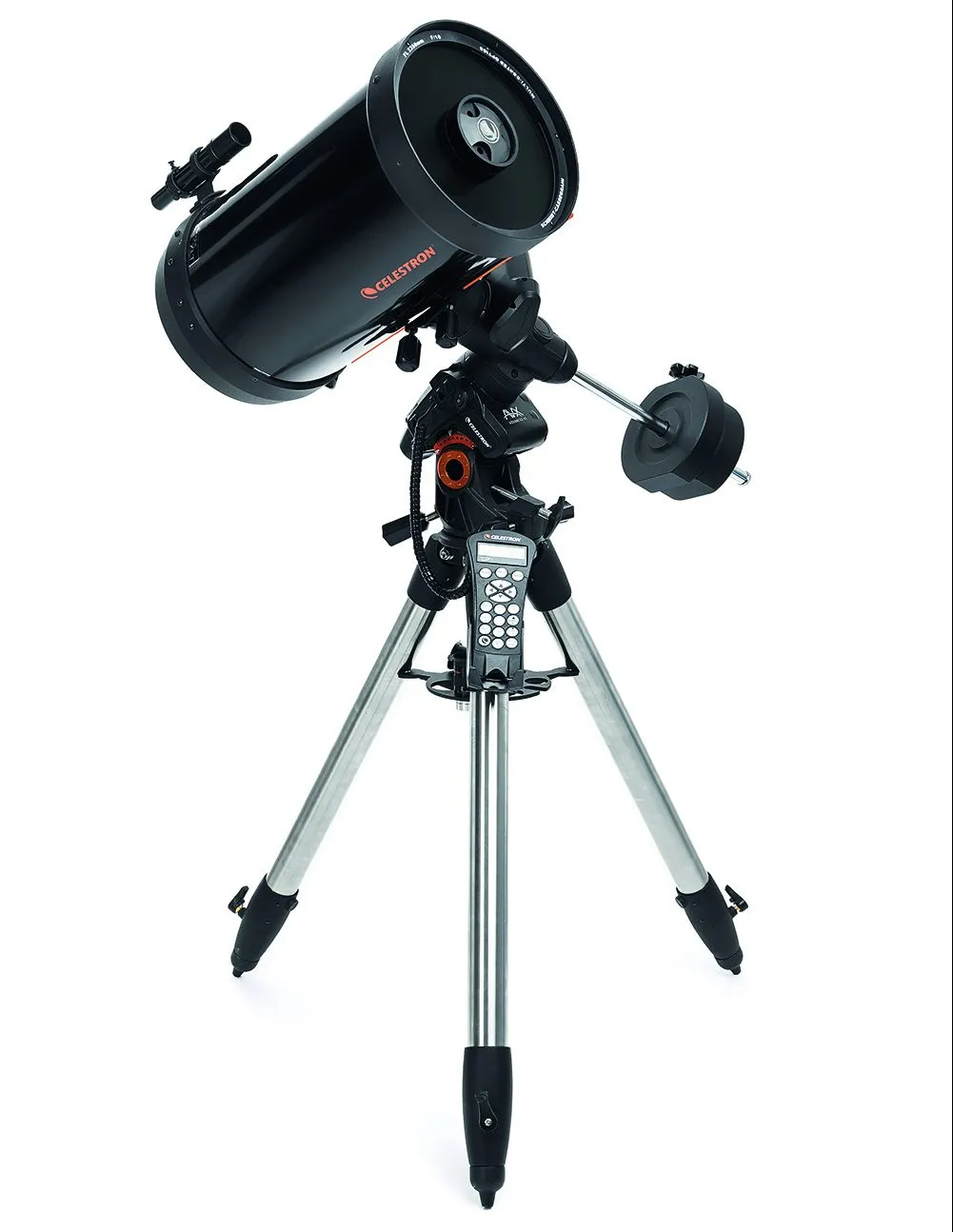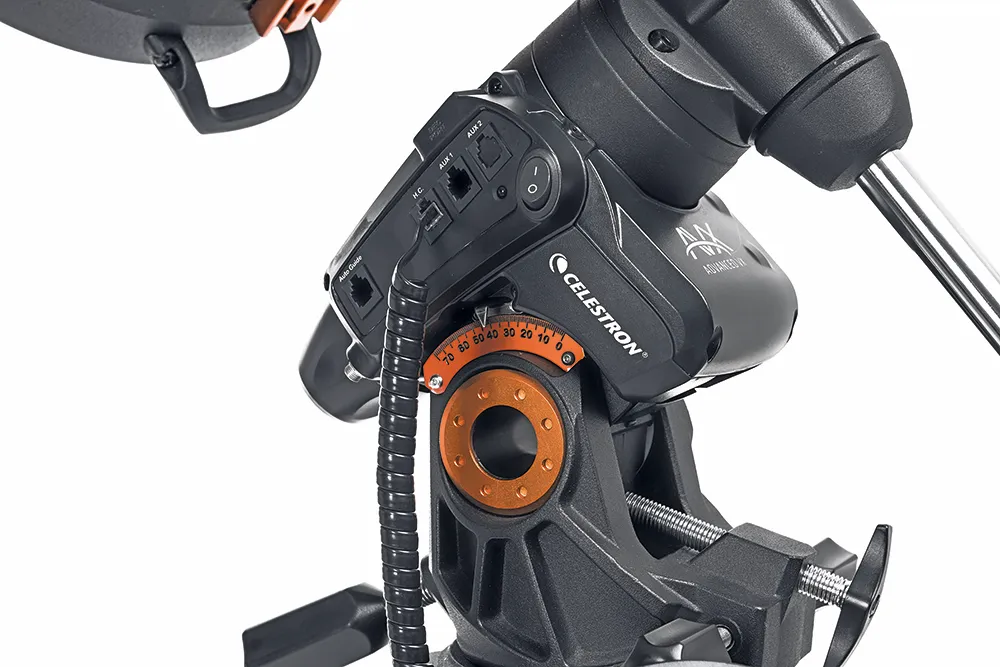The Celestron Advanced VX mount and C9.25 telescope make for an impressive setup that packs a punch in terms of viewing potential.
Easy to transport and straightforward to assemble, the C9.25’s 9.25-inch (235mm) aperture is generous, gathering a third more light than an 8-inch (200mm) reflector.
Its f/10 optics put it in the slow category and, in theory at least, it is best suited for Solar System objects.
However, if your interest is deep sky, it’s no slouch on that front either. On our first night out, we couldn’t resist a peek at an old friend, the Orion Nebula, M42.
Using the supplied 24mm eyepiece gave us 98x magnification. The nebula’s bright core practically filled the view, bumpy, mottled and full of detail.
At its heart, the main stars of the Trapezium cluster were beautifully split. To be fair, the central portion of M42 is an easy target.
Less so the dimming tendrils of glowing gas that arc away from it. Through the VX they were fascinating to follow and extended for quite some distance.
We also liked the view of M42’s fainter neighbour, De Mairan’s Nebula, M43. Its classic comma shape was easy to see thanks to the contrast delivered by the C9.25’s Starbright/XLT-coated optics.
This telescope features in our guide to the best telescopes for observing planets

Focusing on the details
Switching to the Moon, the view was exquisitely sharp.
The 5km-wide Rima Ariadaeus appeared like a scratch across the lunar surface and we were really impressed with the intricate detail in the central mountains of the 101km crater Theophilus.
Turning the view to a rather tiny Mars, its colour, disc and phase were very evident.
Despite poor seeing conditions, we could clearly see one of its polar caps and evidence of surface markings.
The AVX mount appears well matched to this size of telescope, providing a solid, yet highly functional platform. The mount head is mostly of metal construction but with some plastic covers.
It’s easy to carry and we found it was straightforward to set up. This makes for a very portable system.
Assembly is quick and lifting the C9.25 onto the mount head is no trouble thanks to the light weight of the optical tube, which is fitted with a carrying handle.
The scope-to-mount coupling is via a long Vixen dovetail on the optical tube.
Once mounted, however, balancing the tube felt a little imprecise owing to the stiffness of the mount’s bearings.
Alignment
The AVX mount’s electronics provide many tweaking options to improve tracking performance. This includes functions to calibrate the RA drive and store permanent periodic error correction.
There are also numerous ways to align the mount for Go-To and tracking operations. Performing a rough polar align followed by a two-star alignment routine was very quick.
Our Go-To experience after this was adequate with the scope pointing close to where it was supposed to be most of the time.
After adding a further calibration star then running a simple ‘all-star polar alignment’ routine, we found our targets centred in the field-of-view each time.
We slewed the scope around the sky a number of times to try and catch it out, but each time the target appeared properly centred.
This was impressive given how quick the initial alignment routines were to complete.
The handset provides an interface to the AVX’s 40,000 object Go-To database. 200 entries here have enhanced information and there’s provision for up to 100 user-defined objects.
The handset also provides for more basic operations, such as manual slewing. Nine slew speeds are provided, the peak rate moving the scope at 4° per second.
This latest version of the AVX mount has a number of improvements over previous versions, including new motors with increased torque.
These give improved tracking and provide more power to overcome slightly unbalanced setups.
The mount also has larger base castings which provide greater stability when using heavier loads.
Suitable for novice and experienced astronomers, the system’s portability and ease of setup are great if you’re in a hurry to get going, while the excellent optics of the C9.25 don’t disappoint.
Look after it well and it will provide a lifetime of astronomical enjoyment.

A scope with scope
The C9.25 telescope is a lovely mid-sized instrument. Its folded optics and aluminium tube make it very light and portable.
With a theoretical limiting visual magnitude of 14.4 , its native 2.35m focal length also gets you up close and personal without too much effort.
The views were bright and high contrast with lunar shadows inky black against a brilliant landscape.
Planetary detail was good as was the view of extended deep-sky objects.
Without doubt this is a great all-round scope.
Focusing was positive with little mirror shift noted.
The provided 6x30 finder felt a little puny but was adequate for most tasks.
Collimation is carried out by adjusting three hex bolts on the external secondary housing.
The scope is also Fastar (Hyperstar) compatible: by using an optional lens assembly in place of the secondary mirror it can be converted from a slow f/10 telescope to a fast f/2 system.
This gathers light 25x faster than in its f/10 configuration, making it ideal for deep-sky imaging.

Equatorial mount head
The equatorial mount head is relatively light, well-designed and very stable when used with the C9.25 telescope.It has large and easy-to-access altitude and azimuth knobs that can be used in conjunction with the internal ‘all-star polar alignment’ routine.The mount’s computer has permanently programmable periodic error correction for improved tracking and features an internal real-time clock.
Tripod
The AVX mount head fits on top of a sturdy, adjustable tripod.The tripod’s height can be varied from a minimum of 1,118mm to a maximum of 1,626mm. It is lightweight, easy to carry and quick to deploy. Simple eyepiece holders are cut into the spreader bar and there’s a plastic clip-on holder for the NexStar+ handset.
Control panel
The control panel provides connection ports for various mount functions.At the top of the panel is the port that connects to the mount’s declination motor.One port provides connection for the NexStar+ handset, another for the connection of auxiliary devices such as an optional GPS.The final port is provided for autoguiding connections.
Motors and bearings
This latest incarnation of the AVX mount uses new, higher-torque motors, which offer improved tracking performance.They are described as being able to overcome slight balance issues.This is a good thing because the mount bearings aren’t completely free-running and this can make finely tunedbalancing tricky to achieve.
NexStar+ handset
The NexStar+ handset provides an interface to the AVX mount’s computer.It’s simple to use and displays information via a four-line, 18-character illuminated LCD display.Elegant design gives easy access to the 40,000 objects in the AVX’s Go-To database as well as providing a simple-to-use directional control cluster.
Vital stats
- Price £2,299
- Optics Schmidt-Cassegrain design
- Aperture 9.25-inch (235mm)
- Focal length 2,350mm (f/10)
- Mount Advanced VX equatorial, load capacity 13.5kg (30 lbs)
- Weight Equatorial head 7.71kg (17 lbs), tripod 8.16kg (18lbs), supplied counterweight 5.4kg (12 lbs)
- Supplier David Hinds Ltd
- Tel 01525 852696
- www.celestron.co.uk
This review originally appeared in the February 2019 issue of BBC Sky at Night Magazine
